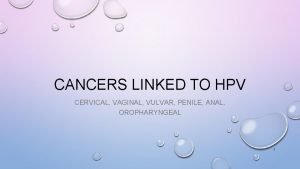Cervical cancer screening and treatment among HIV women



- Slides: 3

Cervical cancer screening and treatment among HIV+ women in Cambodia: feasible and high yielding 1 Médecins M. -E. Raguenaud 1, P. Isaakidis 1, S. A. Khim 1, C. Ping 2, C. Kim 1, L. Martello 1, T. Reid 3 Sans Frontières (MSF), Cambodia, 2 Reproductive Health Association of Cambodia (RHAC), 3 Médecins Sans Frontières, Operational centre of Brussels Background: HIV-infected women have a higher risk of cervical intraepithelial neoplasia (CIN) and cervical cancer than the general population Objectives of pilot screening: To assess feasibility of offering cervical screening for patients attending two HIV clinics under routine programme conditions. Intervention: • A referral system was set up between each HIV clinic and a near-by reproductive health clinic • Women were counseled on the relevance of cervical screening in the HIV clinic • Women accepting screening were referred to the reproductive health clinic where PAP smears were done. • Referral of patients with abnormal PAP smears (for biopsy and treatment) was organized by the HIV clinic. • All services were offered free of charge for patients and support for transportation was provided where possible.

RESULTS Total consecutive women screened 200 - Median age : 35 years - No on ART : 150 Yield • Number with abnormal PAP smear: 53 (26%) • Number with pre-cancerous lesion or cervical cancer: 34 (17%) Uptake of services • Biopsy acceptance: 34/53 (64%) • Treatment uptake: 28/34 (82%) • Loss to follow-up among women with abnormal cytology: 7/53 (13%)

LESSONS LEARNED • A high yield was obtained in offering cervical cancer screening in HIV+ women • • One in four patients screened had abnormal cytology One in five patients screened had pre-cancerous lesion or cervical cancer • Integrating cervical cancer screening in an HIV program provides an “opportunity” for achieving good coverage and follow-up rates as women are regular clinic attendees and a recall system is in place • Need for referral for biopsy hinders uptake of services • A “one-stop service” with a point-of-care “minimal package” of VIA screening + cryotherapy treatment seems most appropriate for this setting





